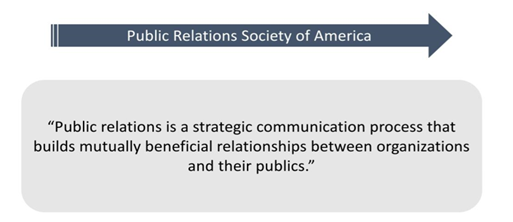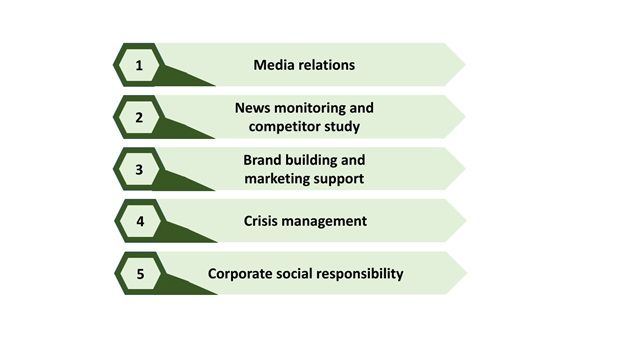What are Public Relations?
Public Relations (PR) is defined as a calculated mode of disclosure to build and enjoy a healthy reputation in the eyes of customers and the public. Many organisations, have adopted Public Relations as an essential method to develop their brand image. PR uses different unpaid or earned ways such as old-fashioned media, digital media, or personal engagements to create a positive standing of the Company. PR is more about storytelling than direct advertising of products and services. The ultimate goal is the same, but the ways are different.
Helen Rosen Woodward, a famous name in the world of advertising and remembered as the first female advertising executive in the US, defined PR in the shortest, best possible sentence:

Image: Kalkine
With every company in the corner, trying to create brand awareness and build a sustainable image, PR has become an enormous need in the world of marketing to stand out from the crowd.
No company in today’s evolving scenario backed by uncertainty can survive without building trust with its customers. Building a brand is a long-term process of creating brand loyal consumers.
Through PR companies build their reputation via non-paid or earned methods
PR is all about persuasion. It is a bridge between the company and the media houses and ultimately the masses. Big companies usually have an in-house PR team, whereas small organisations mainly outsource PR work. The motive of having a PR team is that no information about the organisation or its product/service reaches the customer without a scan through PR.
PR is about convincing your target audience, influencing them to promote your product or services and ultimately resulting in a purchase. It is not a direct promotion like marketing.
Public relations are a supportive method for marketing. If done effectively, companies can achieve results like more sales and higher revenue, drive the market demand for the company’s output, and alter the state of the company's condition and impact its awareness. Effective public relation campaigns can do wonders as it builds brand credibility.

Image: Kalkine
Quick history:
Public relations reference goes back to the early 20th century. The concept has evolved extensively since then. Two main aspects of PR are press agentry and publicity, though current PR is much more than this, they still hold importance. Today’s PR emphasises on engagement and relationship building with the media.
Various tools that PR uses?
- Writing and disseminating press releases
- Speech writing for the company spokesperson
- Creating a monthly and quarterly agenda to meet the objective.
- Writing small pitch notes to the media in order to persuade them to cover the company or product/ services
- Organise company spokesperson and media meetings to build and enhance relationships
- Personal networking with the media
- Content creation for blog or authored articles to be published in media
- Creating an effective crisis strategy
What is the purpose and role of Public Relations?
Most companies have understood the importance and differentiation between marketing and public relations. Organisations now consider PR as an essential tool to overall build a positive image and increase sales. Apart from having an internal PR source, companies also hire external PR agencies. The primary purpose of the PR is to understand the company's objectives and vision & mission and communicate the information on behalf of the company to news media houses in the most effective manner.
The ways and means to get the information published in the media could be different and may be dependent upon the type of firm and industry the company belongs.
In today’s digital landscape, the news cycle and news life are measured in the second rather than days. This system has evolved increasingly since the birth of the internet and has become more challenging for the PR team to control the flow of information. Earlier a simple press release or press conference would meet most of the objective, now with an increase in media houses and the endless churn of content, PR has to deploy a multitude of strategies and tactics to meet the bottom-line business goal.

Image: Kalkine
Let us glance through a few fundamental roles of PR:
- Media relations: PR requires developing a trust, reliability and credibility with media houses to get the stories and content published. PR strengthens its ties with the news media industry to communicate the company’s information effectively. The activities under this head may include arranging press conferences for new product launch, annual meetings, management changes etc.
- News monitoring: Today, content is not just published in newspapers or magazines, but it also appears on TV, radio, internet, social media etc. PR then uses various media monitoring tools to keep the tab on company information being published anywhere in the world. They also analyse and study competitor companies' media coverages to understand their standing in terms of news share and change the PR strategies, if needed, to meet the goal and get ahead of competitors.
- Brand building: PR, through a series of favourable communication, builds a brand image not just in the eyes of consumers but also media. PR extends its full support to the marketing team in order to achieve a holistic result.
- Crisis management: It takes years to build an image, but a few negative articles in the media can destroy it in seconds. Hence effectively managing crises that threaten company or product image and reduce the damage is also one crucial role of PR.
- Corporate social responsibility: Another critical aspect while maintaining a strong image is building goodwill in society. Through philanthropic work, social programs, CSR events PR bring out a noble side of businesses.
How to measure PR effectiveness and value?
As per standard tool, a PR activity or campaign is evaluated through qualitative and quantitative measures. There are various software’s available in the market, which gives a precise analysis output of PR coverage in the media.
Examples of Few Tools:
- Website Traffic
- Market Surveys
- Media Monitoring
Whereas the value of PR is decided upon the advertising space value of the publication. The evaluation is conducted on various aspects such as - if the company/product name is in the headline, how much space it is occupying in the printed media if the company/ product image is used if the brand logo is visible in the picture.
There are many such factors which are considered while evaluating printed news of the organisation. If it's in television media then the duration of the report, visuals, brand name mention such factors are considered and then compared it to the advertising cost of that channel to measure the value of PR.
 Please wait processing your request...
Please wait processing your request...